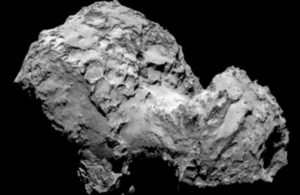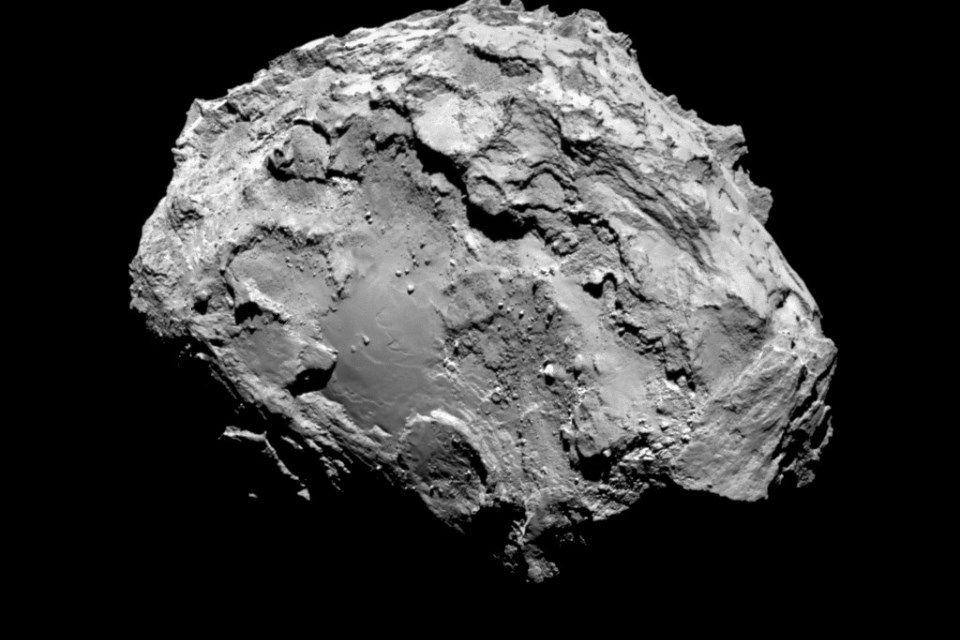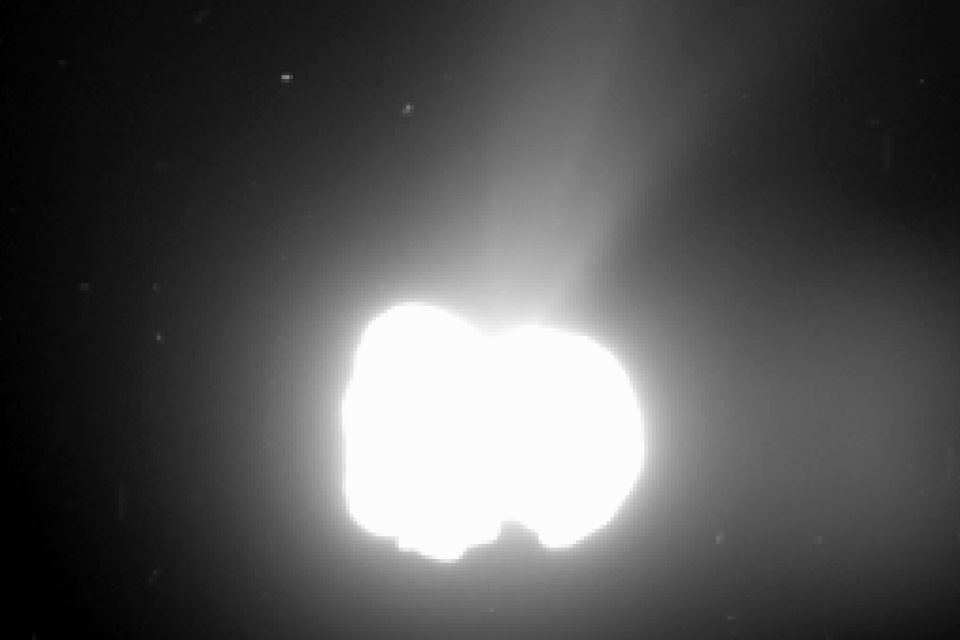Rosetta arrives at comet destination
Europe’s Rosetta has today become the first spacecraft to rendezvous with a comet, opening a new chapter in Solar System exploration.

Comet 67P/Churyumov-Gerasimenko by Rosetta’s OSIRIS narrow-angle camera on 3 August from a distance of 285 km. The image resolution is 5.3 metres/pixel. Credits: ESA/Rosetta/MPS for OSIRIS Team MPS/UPD/LAM/IAA/SSO/INTA/UPM/DASP/IDA.
This milestone is a big win for the UK space industry which has significant involvement in the mission.

Comet 67P/Churyumov-Gerasimenko by Rosetta’s OSIRIS narrow-angle camera on 3 August from a distance of 285 km. The image resolution is 5.3 metres/pixel. Credits: ESA/Rosetta/MPS for OSIRIS Team MPS/UPD/LAM/IAA/SSO/INTA/UPM/DASP/IDA.
Minister of State for Universities and Science Greg Clark said:
Rosetta is a big mission for the UK, with much of the spacecraft built and designed here and our scientists involved in 10 of the mission’s instruments.
As the spacecraft makes history as the first to orbit a comet as it swings around the Sun, our UK Rosetta scientists and engineers will be ‘on-board’ for the trip of a lifetime, ready to unlock the secrets of this time capsule from the dawn of our Solar System.
Comet 67P/Churyumov–Gerasimenko and Rosetta now lie 405 million kilometres from Earth, about half way between the orbits of Jupiter and Mars, rushing towards the inner Solar System at nearly 55 000 kilometres per hour.
The comet is in an elliptical 6.5-year orbit that takes it from beyond Jupiter at its furthest point, to between the orbits of Mars and Earth at its closest to the Sun. Rosetta will accompany it for over a year as they swing around the Sun and back out towards Jupiter again.
Comets are considered to be primitive building blocks of the Solar System and may have helped to ‘seed’ Earth with water, perhaps even the ingredients for life. But many fundamental questions about these enigmatic objects remain, and through a comprehensive, in situ study of the comet, Rosetta aims to unlock the secrets within.
The comet began to reveal its personality while Rosetta was on its approach. Images taken by the OSIRIS camera between late April and early June showed that its activity was variable whilst the stunning images taken from a distance of about 12 000 km began to reveal that the nucleus comprises two distinct segments joined by a ‘neck’, giving it a duck-like appearance. Subsequent images showed more and more detail – the most recent, highest-resolution image was downloaded from the spacecraft earlier today and will be available this afternoon.

Comet 67P/Churyumov-Gerasimenko activity on 2 August 2014. The image was taken by Rosetta’s OSIRIS wide-angle camera from a distance of 550 km. The exposure time of the image was 330 seconds and the comet nucleus is saturated to bring out the detail of the comet activity. Note there is a ghost image to the right. The image resolution is 55 metres per pixel. Credits: ESA/Rosetta/MPS for OSIRIS Team MPS/UPD/LAM/IAA/SSO/INTA/UPM/DASP/IDA.
Our first clear views of the comet have given us plenty to think about,
says Matt Taylor, ESA’s Rosetta project scientist.
Is this double-lobed structure built from two separate comets that came together in the Solar System’s history, or is it one comet that has eroded dramatically and asymmetrically over time? Rosetta, by design, is in the best place to study one of these unique objects.
Today, Rosetta is just 100 km from the comet’s surface, but it will edge closer still. Over the next six weeks, it will describe two triangular-shaped trajectories in front of the comet, first at a distance of 100 km and then at 50 km.
At the same time, more of the suite of instruments will provide a detailed scientific study of the comet, scrutinising the surface for a target site for the Philae lander.
Eventually, Rosetta will attempt a close, near-circular orbit at 30 km and, depending on the activity of the comet, perhaps come even closer.
As many as five possible landing sites will be identified by late August, before the primary site is identified in mid-September. The final timeline for the sequence of events for deploying Philae – currently expected for 11 November – will be confirmed by the middle of October.
Among its wide range of scientific measurements, Philae will send back a panorama of its surroundings, as well as very high-resolution pictures of the surface. It will also perform an on-the-spot analysis of the composition of the ices and organic material, including drilling down to 23 cm below the surface and feeding samples to Philae’s on-board laboratory for analysis.
The focus of the mission will then move to the ‘escort’ phase, during which Rosetta will stay alongside the comet as it moves closer to the Sun, monitoring the ever-changing conditions on the surface as the comet warms up and its ices sublimate.
Speaking about the Philae lander’s UK-led Ptolemy instrument – a laboratory the size of a small shoebox - Ian Wright, Professor of Planetary Sciences at The Open University, said:
Once the Philae lander touches down on the comet, we will be looking for evidence recorded in remnants of debris that survived the processes of planet formation. This is not merely a period of pre-history, but one that pre-dates the origin of life itself. Our quest is to gain insights into this transitional era, which took place more than 4.5 billion years ago.
Rosetta and the UK
With funding from the UK Space Agency, Rosetta is a mission with significant UK involvement. UK scientists are involved in ten of the 21 experiments that Rosetta will carry out during its mission:
- the Open University is leading the team for the Ptolemy instrument on the lander
- Armagh Observatory will be helping to analyse the results from the OSIRIS instrument
- Imperial College London and University College London’s Mullard Space Science Laboratory (MSSL) supply the team studying the comet’s plasma
- scientists at Oxford University are part of the science team for VIRTIS
- Queen Mary College at the University of London will be investigating the results of the CONSERT instrument
Industry involvement includes:
- Astrium Limited, based in Stevenage, was the major subcontractor for the Rosetta platform
- the Science & Technology Facilities Council (STFC) Rutherford Appleton Laboratory managed to reduce a lab full of chemistry equipment to enable it to fit into a space the size of a shoebox
- SciSys UK Ltd is responsible for the spacecraft Mission Control System development and maintenance; in recognition of this work on the Rosetta and the Beagle 2 missions, SciSys were awarded the title of “Innovator of the Year” by the UK Computing Awards for Excellence 2004
- VEGA Group plc was involved in many aspects of the Rosetta mission, from the overall design of the spacecraft to the on board software technology created by Logica (now CGI) helped to explore some of the issues involved in such a long mission, the company was also involved in the development of the Rosetta on board software.
- AEA Battery Systems Limited provided innovative batteries for the spacecraft and lander. These are smaller, lighter and much more reliable than the traditional nickel-cadmium batteries
- AEA Technology, European Space Tribology Laboratory (ESTL) developed the Micro-Imaging Dust Analysis System (MIDAS)
- Polyflex Space Ltd provided tanks to store the helium used by the lander
- Surrey Satellite Technology Limited (SSTL) designed a wheel that will stabilise the probe as it descends and lands on the comet